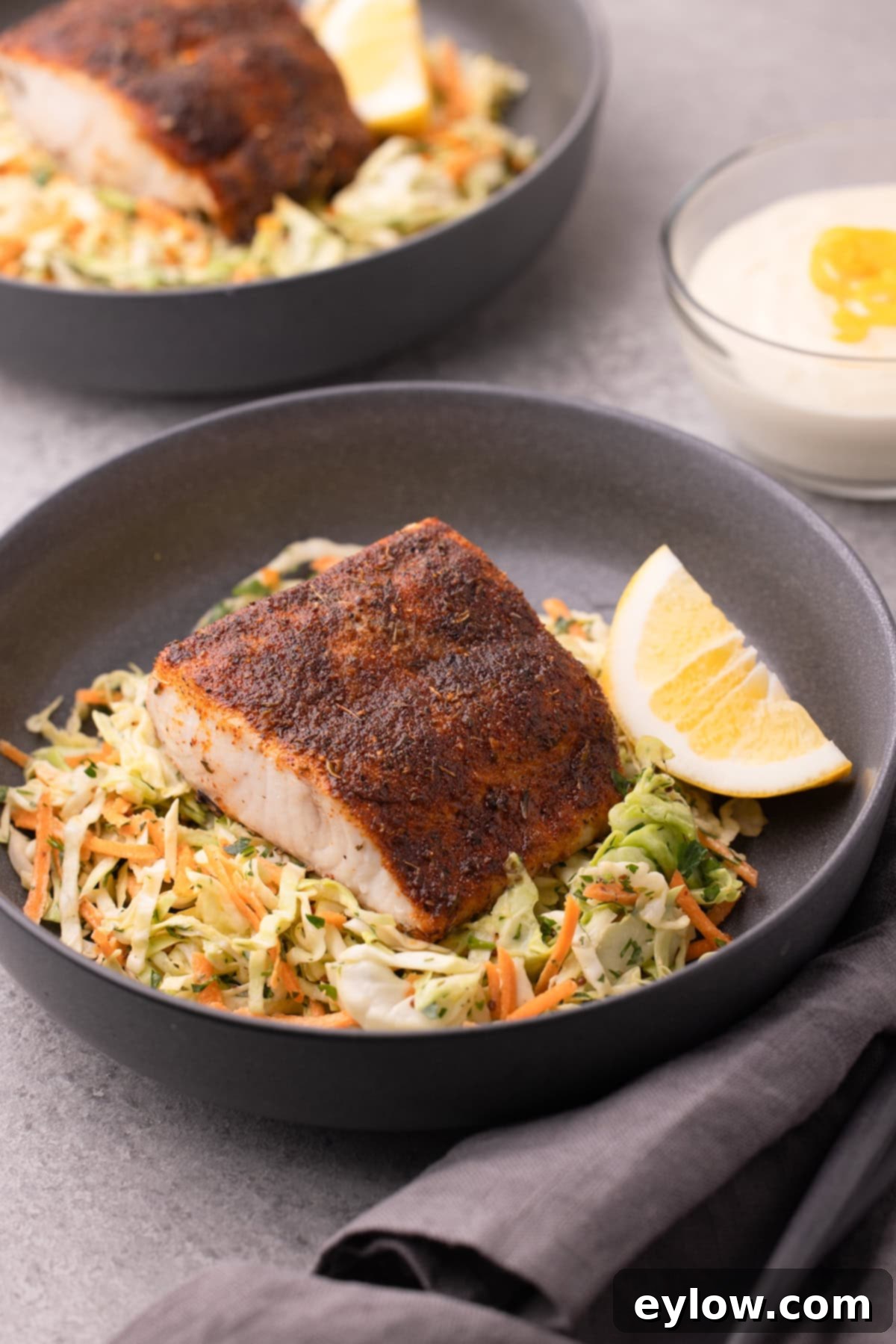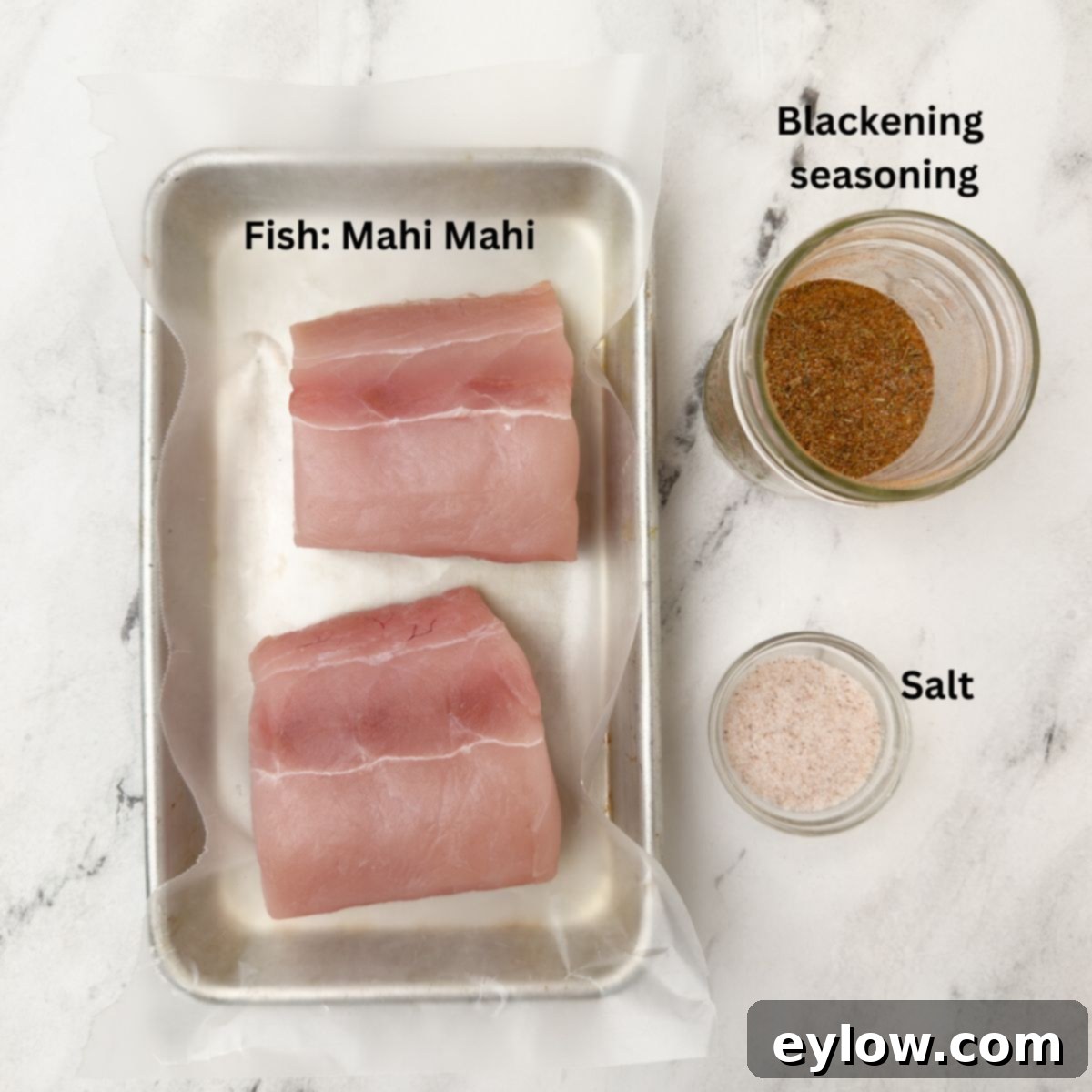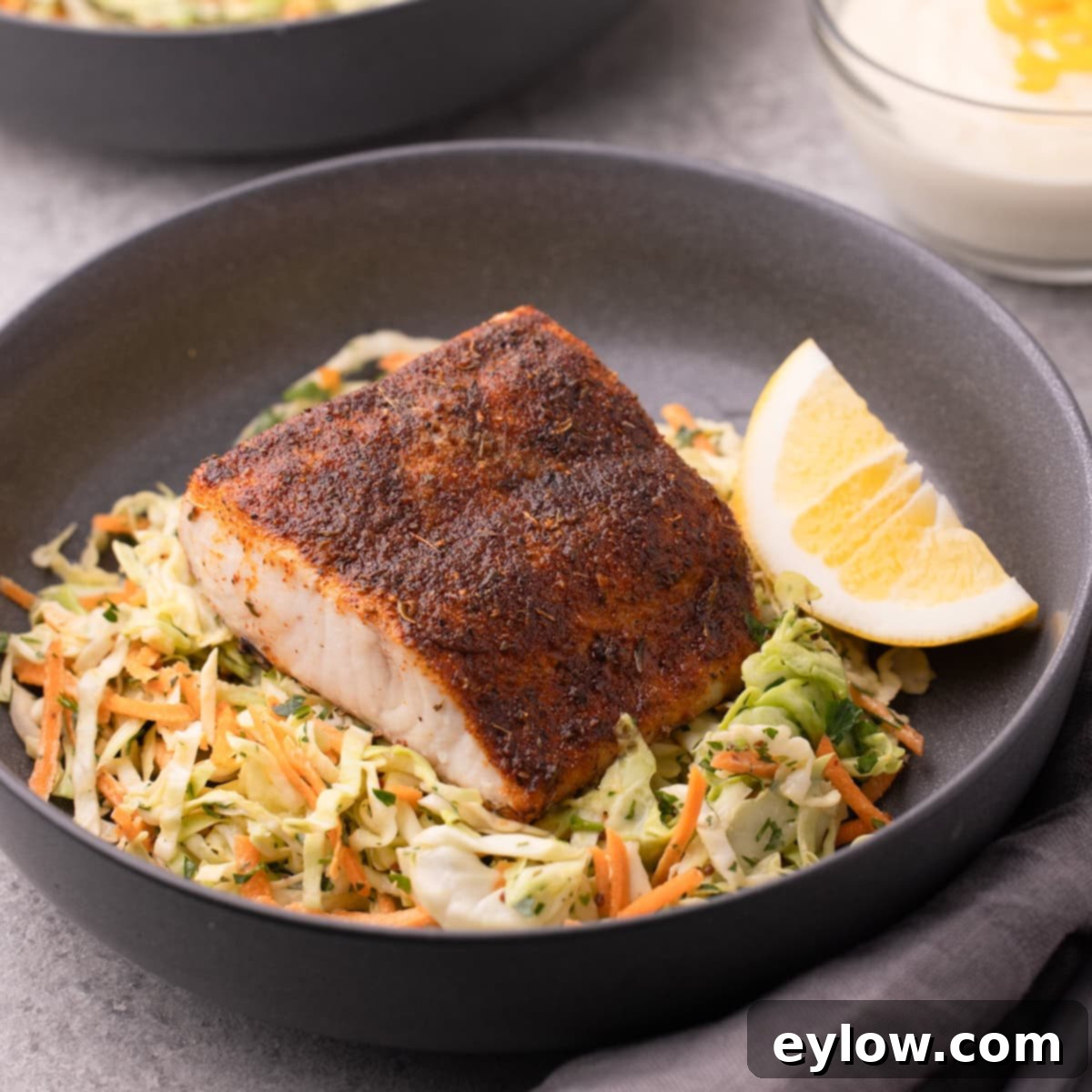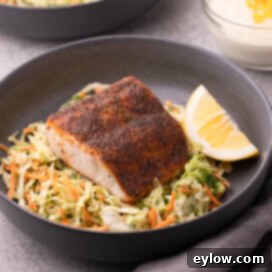Air Fryer Blackened Mahi Mahi: Spicy, Speedy, and Super Simple Seafood Dinner
Dinner doesn’t get much easier – or tastier – than this incredible Air Fryer Blackened Mahi Mahi. Bursting with bold Cajun-inspired spices and cooked to perfection in mere minutes, this healthy seafood recipe is a weeknight lifesaver. You can have a restaurant-quality meal on your table in under 10 minutes, making it ideal for those busy evenings when you crave something nutritious and packed with flavor. For the ultimate taste, I highly recommend using my homemade blackening seasoning recipe, which is included below. It’s not only fast and flavorful but also incredibly versatile. No air fryer? No problem! This delicious dish can also be prepared on the stovetop with equally fantastic results.

Ever since I invested in an air fryer, it has quickly become my absolute favorite method for cooking fish. The convenience and speed it offers are simply unmatched! This blackened mahi mahi recipe yields perfectly cooked fish with a delightful crust and juicy interior every single time. Serving it with a quick squeeze of fresh lemon juice or a dollop of zesty lemon aioli adds a bright, creamy contrast that beautifully balances the smoky, spicy notes from the blackening rub. It’s a culinary experience that feels gourmet yet is incredibly simple to achieve.
[feast_advanced_jump_to]
Why This Air Fryer Blackened Mahi Mahi Will Become Your New Favorite
This Blackened Mahi Mahi recipe isn’t just another fish dish; it’s a testament to how effortlessly healthy and incredibly flavorful meals can be. Here’s why you’ll absolutely love adding it to your rotation:
- Unbeatable Speed & Flavor: This recipe is lightning-fast, making it perfect for busy weeknights when you need a healthy dinner in a flash. Despite its rapid cook time, the bold Cajun flavors penetrate the fish, delivering a truly satisfying culinary experience.
- Perfect Air Fryer Results: The air fryer is a game-changer for fish. It creates a wonderfully crispy, dark “blackened” crust while keeping the mahi mahi incredibly moist and tender on the inside, all without excessive oil or a smoky kitchen.
- Versatile Fish Options: Can’t find mahi mahi? No worries! This blackening technique and seasoning work beautifully with a variety of other firm white fish or even salmon, ensuring you can always enjoy this fantastic flavor profile.
- Simple & Elegant Serving: Whether you opt for a squeeze of fresh lemon juice for a minimalist approach or a creamy lemon aioli for extra indulgence, the serving options are straightforward and always enhance the dish.
- Multi-Purpose Seasoning: The homemade blackening seasoning isn’t just for fish! Make a larger batch and use it to elevate chicken, shrimp, pork, or even vegetables, adding a spicy, smoky kick to countless meals.
While creamy riced mashed potatoes offer a comforting classic side, for those seeking a lower carb alternative, this cheesy cauliflower rice is an excellent and equally delicious choice. Explore these options to complete your meal.
Essential Ingredients for Perfect Blackened Mahi Mahi


Creating sensational blackened mahi mahi starts with quality ingredients. Here’s what you’ll need, along with tips for selecting the best:
For the Fish:
- Mahi Mahi Fillets – This firm, mild white fish is an ideal canvas for the robust blackening spices. Its dense texture holds up well to high heat without falling apart, ensuring beautiful, intact fillets. Opt for fresh mahi mahi if available, or use high-quality frozen fillets that have been completely thawed in the refrigerator overnight. Always pat the fish thoroughly dry with paper towels before seasoning to encourage a crispy crust.
- A Touch of Oil (Optional, for seasoning adhesion) – A very light brush of extra virgin olive oil or avocado oil on the fish before seasoning helps the spice rub adhere effectively. This also contributes to the development of a beautiful, flavorful crust in the air fryer.
- Avocado Oil Spray – A quick mist of avocado oil spray over the seasoned fish before cooking, and halfway through, serves multiple purposes. It helps achieve that desirable slight sheen and ensures the fish remains moist during the rapid cooking process, preventing dryness. Additionally, it significantly aids in forming that signature “blackened” crust, giving your fish an authentic look and taste.
For the Homemade Blackening Seasoning:
Making your own blackening seasoning allows for complete control over the flavor and heat level. You can customize the spice by adjusting the amount of cayenne or chipotle pepper. If you’re sensitive to heat, start with a very small quantity and gradually increase it until you reach your preferred intensity. For convenience, a good quality store-bought spice mix can be used as a shortcut, but homemade is always best for freshness and flavor vibrancy.
- Smoked Paprika – This is the cornerstone of the blackening blend, lending its signature dark color and a rich, irresistible smoky depth. For a more classic, less smoky Cajun profile, sweet paprika can be used as a traditional alternative.
- Granulated Garlic Powder – An indispensable ingredient that provides a foundational savory flavor, crucial for any robust spice blend.
- Onion Powder – Complementing the garlic, onion powder adds another layer of savory intensity and balances the overall spice profile.
- Dried Thyme – Contributes subtle herbal notes that are characteristic of classic Cajun and Creole cuisine, adding aromatic complexity.
- Dried Oregano – Another staple in Southern spice blends, dried oregano enhances the herbal backbone of the seasoning, pairing wonderfully with thyme.
- Black Pepper – A non-negotiable component, freshly ground black pepper provides essential pungency and a touch of warmth.
- White Pepper – Often overlooked, white pepper works in tandem with black pepper to build a more nuanced heat and sharpness. It introduces a subtle, earthy complexity that truly elevates the seasoning – highly recommended for an authentic taste.
- Cayenne Pepper – This is where the classic Cajun heat comes from. As mentioned, start with a smaller amount (¼ teaspoon) if you’re spice-sensitive, and gradually add more (up to ½ teaspoon or even a bit more) to achieve your desired level of kick. Alternatively, chipotle powder can be used for a smoky heat.
Remember to refer to the recipe card below for precise measurements and the recommended amount of salt for a perfectly balanced seasoning blend. The right balance of salt is crucial for bringing out all the other flavors.
Chef’s Tip: Blackened or Blackening? It’s a common point of confusion! “Blackening” refers to the specific seasoning blend used, a vibrant mix of spices designed for intense flavor. “Blackened” describes the cooking technique itself, where food (like fish) is coated in this seasoning and then cooked at high heat to form a dark, flavorful crust. It’s the action and the result.
Substitutions and Creative Variations
While mahi mahi is excellent for this recipe, you have plenty of options to customize it to your taste or what’s available:
- Fish Alternatives: If mahi mahi isn’t on hand, this blackening seasoning is truly terrific on other firm fish. Salmon is a fantastic alternative, with its rich flavor and meaty texture holding up beautifully to the bold spices. For other white fish, consult the FAQ section below for more excellent choices like halibut, snapper, or grouper. Even cod can work if handled gently.
- Chipotle Powder for Smoky Heat: For a deeper, smoky dimension, consider swapping some or all of the cayenne pepper with chipotle powder. While not strictly traditional in classic blackening blends, it adds a wonderful depth of flavor that complements the other spices perfectly.
- A Hint of Brown Sugar: A small amount of brown sugar (about ½ to 1 teaspoon) can be added to your blackening seasoning blend. It provides a subtle sweetness and, more importantly, aids in creating a beautiful, caramelized crust when searing. It’s a non-traditional but highly recommended addition if you appreciate that extra hint of caramelization.
- Citrus Twist: Instead of lemon juice, finish your blackened fish with a squeeze of fresh lime juice. Lime offers a slightly different, tangy brightness that can be a delightful change, especially if you’re serving with a more tropical-inspired side like mango salsa.
Serve your air fryer mahi mahi alongside a vibrant side of sweet corn succotash. The fresh sweetness of the corn and edamame provides a wonderful contrast to the robust Cajun spices, making for a truly harmonious meal.
Chef’s Tip: Is Homemade Cajun Seasoning the Same as Blackening Seasoning? While similar, Cajun seasoning is a general-purpose spice blend, often milder and used to flavor a wide range of dishes. Blackening seasoning, however, is a bolder, often spicier variation specifically formulated for the high-heat blackening method. It was famously popularized by New Orleans chef Paul Prudhomme. Think of blackening seasoning as Cajun’s more intense, crust-forming cousin. And yes, it works wonders on more than just fish – try it with chicken breast, pork chops, or shrimp for a fantastic flavor boost!
Simple Steps for Air Fryer Blackened Mahi Mahi
Preparing blackened mahi mahi in the air fryer is incredibly straightforward, promising a fast and incredibly delicious dinner. The key to success is minimal fuss and proper preparation. One crucial note: if you’re using frozen fish fillets, ensure they are completely thawed and thoroughly patted dry before you begin. Excess moisture can prevent that perfect crust from forming.

- Prepare the Seasoning: In a small bowl or a jar with a tight-fitting lid, combine all the blackening spices. Mix them well or shake the jar vigorously until thoroughly blended. This ensures an even distribution of flavor. Next, prepare your mahi mahi fillets by patting them very dry with paper towels. This step is critical for achieving a beautiful, dark crust.

- Season the Fish: Lightly spray or brush your dry mahi mahi fillets with avocado oil. Then, generously coat all sides of the fish with the blackening seasoning blend. Don’t be shy – the seasoning creates the signature “blackened” crust and flavor! Ensure an even layer for consistent results.

- Air Fry to Perfection: Preheat your air fryer to 385°F (196°C). Once preheated, lightly spray the air fryer basket with avocado oil if needed to prevent sticking. Carefully place the seasoned mahi mahi fillets in a single layer in the basket, ensuring not to overcrowd it. Cook for 7-8 minutes. Halfway through the cooking time (around 3-4 minutes), give the fish another quick mist of avocado oil spray. This helps enhance the “blackened” crust and keeps the fish beautifully moist and shiny.
Blackened mahi mahi fillets are perfectly cooked when their internal temperature reaches 140°F-145°F (60°C-63°C). This typically takes 7-8 minutes in a preheated air fryer, depending on the thickness of your fillets. Use a digital instant-read thermometer inserted into the thickest part of the fish to confirm doneness. Once cooked, remove from the air fryer and serve immediately for the best texture and flavor.
Chef’s Note: Mahi Mahi and “Dolphin Fish” Confusion. In some parts of the U.S., particularly Florida and along the East Coast, mahi mahi is sometimes referred to as “dolphin fish.” It’s important to clarify that this common name is misleading and can cause confusion. Mahi mahi is a distinct species of ray-finned fish (Coryphaena hippurus) and is absolutely not related to dolphins, the beloved marine mammals. The Hawaiian name “mahi mahi” (meaning “strong-strong”) has thankfully become the more widely accepted and used term in culinary contexts and stores today, helping to avoid any misconceptions.
Delicious Serving Suggestions for Blackened Mahi Mahi
Once your Air Fryer Blackened Mahi Mahi is perfectly cooked, it’s time to assemble a meal that truly highlights its bold flavors. Here are some fantastic serving ideas:
- The Classic Citrus Finish: Always serve blackened mahi mahi with plenty of fresh lemon wedges. A simple squeeze of lemon juice adds a burst of acidity that brightens the rich, spicy flavors of the fish and cuts through any richness.
- Creamy Lemon Aioli: For an extra touch of creamy indulgence that perfectly complements the smoky seasoning, whip up a quick lemon aioli. You can easily make this in just 5 minutes by combining good quality mayonnaise with fresh lemon juice, lemon zest, a minced garlic clove, and a touch of Dijon mustard. It’s a game-changer!
- Simple Grains and Greens: A side of fluffy white rice provides a neutral base to soak up all the delicious flavors. Alternatively, a crisp, lightly dressed green salad offers a refreshing counterpoint.
- Tropical Flair: For a more vibrant and exotic pairing, consider a creamy avocado basil dip with a squeeze of lime, or a refreshing fresh mango salsa. The sweet and tangy notes of these accompaniments create a delightful balance with the spicy fish.
- Melted Butter: Since mahi mahi is a lean fish, a drizzle of simple melted butter (garlic butter, if you’re feeling fancy) can add a lovely richness and moisture, enhancing its natural flavor.
- Homemade Coleslaw: A cool, crisp, and lightly dressed homemade coleslaw provides a fantastic textural and temperature contrast to the warm, spicy fish.
- Hearty & Crunchy Salads: Serve alongside a crunchy broccoli salad with bacon for a more substantial and satisfying meal with added texture.
- Sweet Potato Sides: Pair with simple whipped sweet potatoes. For an extra kick, try incorporating some of your homemade blackening spices into the sweet potato mash!
Storing and Reimagining Leftovers
For the absolute best flavor and texture, it’s recommended to enjoy leftover blackened mahi mahi within 1 to 2 days of cooking. While cooked fish can technically be stored in an airtight container in the refrigerator for up to 3-4 days, it tends to dry out and lose its optimal quality beyond the second day. Always ensure it’s stored properly to maintain freshness.
One of the most delicious ways to repurpose leftover blackened mahi mahi is by transforming it into fantastic fish tacos! Simply shred or flake the cooked fish, warm it gently, and serve with warm corn tortillas, thinly sliced cabbage for crunch, a squeeze of fresh lime juice, a sprinkle of grated cheese (like cotija or Monterey Jack), and perhaps some diced avocado or a dollop of sour cream or crema. They are incredibly delicious, quick to assemble, and make for a perfect lunch or a casual dinner.

Common Questions About Blackened Mahi Mahi
Absolutely! While the air fryer provides exceptional convenience, you can easily achieve delicious blackened mahi mahi using other methods. The most traditional way is to pan-sear it in a very hot, large cast-iron skillet over medium-high heat with a little high-smoke point oil like avocado oil. Get the pan screaming hot to create that signature dark crust. You can also grill it; ensure your grill grates are clean and well-oiled to prevent sticking, and cook over direct medium-high heat for a few minutes per side until done.
Blackening is a distinctive cooking technique that involves coating food (most commonly fish or chicken) generously in a bold, often spicy, dry spice rub. The seasoned food is then cooked at very high heat, typically in a cast-iron skillet or air fryer, until a dark, flavorful crust forms on the exterior. It’s crucial to understand that “blackened” means a deeply browned and intensely flavorful crust, not burnt. The high heat caramelizes the spices and cooks the exterior quickly, sealing in moisture and creating a complex taste.
Yes, definitely! While mahi mahi is an excellent choice for blackening due to its firm texture and mild flavor that can stand up to bold spices, many other types of fish work wonderfully. Salmon is a fantastic alternative, offering a richer flavor and meaty texture that becomes incredibly delicious when blackened. Other great options for firm white fish include halibut (mild, firm, slightly sweet), snapper (lean with a nice texture), or grouper (similar to mahi in firmness and mildness). You can also use cod, particularly loin cuts, but handle it more gently as it’s a more delicate fish and may flake apart easily, especially in an air fryer.
Blackened fish, like most fish dishes, is truly best served fresh immediately after cooking to enjoy its optimal texture and moisture. However, you can certainly prepare some components ahead of time. The homemade spice rub can be mixed and stored in an airtight container for weeks, ready to use whenever you are. You can also coat the fish with the blackening seasoning a few hours before cooking; just store it covered in the refrigerator until you’re ready to air fry. If you have any cooked leftovers and are planning to make blackened mahi mahi tacos, you can cook the fish a day ahead, then gently reheat and shred it for a super-fast and flavorful lunch or dinner the next day.
Explore More Delicious Fish and Seafood Recipes
For more delectable fish and seafood recipes that are sure to please all seafood lovers, including mouth-watering options featuring shrimp, scallops, halibut, salmon, and much more, be sure to check out our comprehensive seafood recipe index. Discover your next favorite meal!
- How to Make Steamed Salmon
- Pan Seared Halibut with Miso Butter
- Sesame Crusted Salmon
- Easy Baked Shrimp Scampi
Did You Make This Recipe? We’d Love to Hear From You!
If you tried your hand at this Air Fryer Blackened Mahi Mahi, please take a moment to add your comment and share your experience below. Your feedback is incredibly valuable, and I genuinely enjoy hearing from you! If you absolutely loved this recipe, please consider giving it a 5-star rating. Your ratings truly help other readers discover and enjoy this delicious and easy seafood dinner.
📖 Recipe

Blackened Mahi Mahi (Air Fryer Recipe)
Sally Cameron
Pin Recipe
Equipment
-
6 quart air fryer
Ingredients
Fish
- 1 ½ pounds mahi mahi fillets (4 – 6 ounce fillets) see substitutes below
- avocado oil spray
Blackening seasoning (makes ½ cup)
- 2 tablespoons smoked paprika or sweet paprika, traditional
- 1 tablespoon granulated garlic powder
- 1 tablespoon onion powder
- 2 teaspoons dried thyme
- 2 teaspoons dried oregano
- 2 teaspoons ground black pepper
- 1 teaspoon white pepper optional but adds depth
- ¼-½ teaspoon cayenne pepper use more for spicy or omit for heat sensitive, or swap chipotle powder
- 1 teaspoon kosher salt
Instructions
-
In a small jar or bowl, combine all the blackening seasoning ingredients: smoked paprika, granulated garlic powder, onion powder, dried thyme, dried oregano, black pepper, white pepper (if using), cayenne pepper, and kosher salt. Shake the jar vigorously or stir well to ensure all spices are thoroughly blended. Set aside.
-
Pat the mahi mahi fillets thoroughly dry with paper towels to remove any excess moisture. If needed, cut larger fillets into 4 equal 6-ounce portions. Lightly spray or brush each fillet with avocado oil, then generously coat all sides with the prepared blackening seasoning. Press the seasoning gently to ensure it adheres well to the fish.
-
Preheat your air fryer to 385°F (196°C) for a few minutes. If necessary, give the air fryer basket a quick spritz of avocado oil to prevent sticking. Once the air fryer is ready, carefully place the seasoned mahi mahi fillets in a single layer in the basket, making sure not to overcrowd them. Cook for 7-8 minutes. At the halfway point (around 3-4 minutes), give the fillets another quick spray of avocado oil. This helps develop that beautiful crust and keeps the fish moist. The fish is done when it flakes easily with a fork and reaches an internal temperature of 140°F-145°F (60°C-63°C) when checked with a digital thermometer in the thickest part.
Carefully remove the blackened mahi mahi from the air fryer and serve immediately with fresh lemon wedges or your desired accompaniments.
Notes
- Salmon – A fantastic alternative with a rich, meaty texture that holds together well and takes on bold seasoning beautifully.
- Halibut – Known for its mild flavor, firm texture, and slight sweetness. It’s a great choice, though often a bit pricier.
- Cod (Loin Cut) – Mild and flaky, but if you opt for thicker loin cuts, it can still be firm enough for blackening. Handle gently, as it can flake apart more easily than mahi mahi.
- Snapper – Varieties like red snapper are lean, boast a lovely texture, and have a pleasant, mild flavor that pairs well with blackening spices.
- Grouper – Offers a firm texture and mild flavor profile very similar to mahi mahi, making it an excellent substitute if you can find it.
